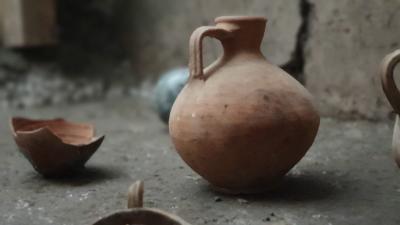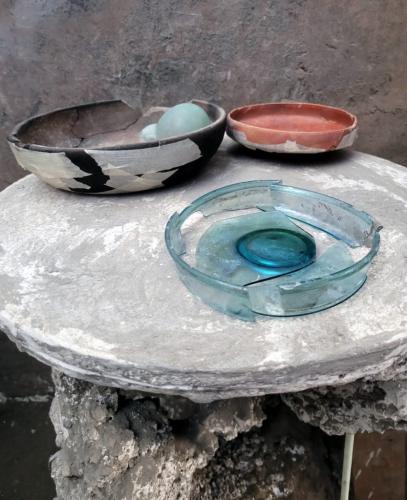Recent excavations in Pompeii shed light on everyday life

POMPEII – Archeologists have discovered a series of rooms in a residence belonging to a middle-class family and their household items in the ancient city, which was engulfed by volcanic ash in 79AD spewing from Mount Vesuvius, giving more information about everyday life in Pompeii.
In the residence, the small, furnished rooms are located around lararium, a room of worship decorated with images of plants and birds. During the recent archeological digs, four new rooms were discovered: two on the ground floor in front of the lararium and others on the first floor.
In the upper rooms, well-preserved ceramic vessels, glass vessels and vessels made from sigillata – a type of Roman fine table ceramic – were found inside a big cupboard, that had been destroyed during the eruption. The vessels were used in everyday life in the kitchen.
Archeologists also unearthed a small cast of waxed tablets. “A truly unique find, it has allowed us to create the first example of a cast which allows a perfect yield of both volume and detail. It is a group of seven triptychs, tied together by a small cord both horizontally and vertically,” said Pompeii officials on the new discovery.
On the ground floor, adjacent to the lararium, is another furnished bedroom with a wooden bed. Next to the bed is a bipartite wooden chest, left open from when the owners escaped from the eruption. A small sigillata tablet and a two-armed lantern with a bas-relief depicting the transformation of Zeus into an eagle were found in the chest.
Italy’s director general of museums, Massimo Osanna, explained the contribution of recent archeological research to knowledge about middle-class everyday life. “In the Roman Empire, there was a significant proportion of the population who fought for their social status and for whom the ‘daily bread’ was anything but taken for granted,” he said.
“It was a social class that was vulnerable during political crises and famines, but also ambitious to climb the social ladder. In the House of the Lararium at Pompeii, the owner was able to embellish the courtyard with the lararium and the basin for the cistern with exceptional paintings, yet evidently funds were insufficient to decorate the five rooms of the house, one of which was used for storage,” Massimo Osanna concluded.
ak-al

© COPYRIGHT ITALIAN INSIDER
UNAUTHORISED REPRODUCTION FORBIDDEN


